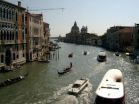(Press-News.org)
Research undertaken by the University of Southampton and its associates in Venice has revealed that the sea surface temperature (SST) in coastal regions is rising as much as ten times faster than the global average of 0.13 degrees per decade.
Researchers believe that this is partly as a result of a process known as the 'urban heat island effect'; where regions experiencing rapid industrial and urban expansion produce vast amounts of heat, making the area warmer than its surroundings.
Professor Carl Amos of Ocean and Earth Sciences at the University of Southampton, will be making a speech at the Estuarine & Coastal Sciences Association's Research & Management of Transitional Waters international symposium, in Lithuania tomorrow (Thursday 27 September). He explains: "The urban heat island effect is a little considered problem with extreme consequences. Take London for example; the air temperature in the capital and the SST of the Thames is always warmer than it is in the rest of the UK. Similarly, in South Korea, an area which has seen rapid industrial expansion, the SST is rising at a rate of 0.26 degrees per decade – significantly higher than the global average. Two thirds of this rise is explained by local air temperature, which is largely driven by the urban heat island effect."
The world's coastal zone occupies 18 per cent of the world's land mass and it is estimated that 1.6 billion people live in these regions world-wide. The coastal population density is three times the global average and this population is expected to increase 30 per cent by 2025, with trade and infrastructure at the coasts also increasing steadily. Research suggests that in coastal regions of high urban development, human activity is directly warming adjacent coastal waters and that this contribution to global warming at the coastal zones is equal to, or greater than, other factors such as greenhouse gasses.
Professor Amos, who is based at the National Oceanography Centre Southampton (NOCS) says: "The Marine Climate Change Impacts Partnership Report of 2006 stated that the capacity to define and predict long-term coastal changes due to human causes is 'unknown' and confidence in results is 'low'. This is a major barrier to planning for inevitable changes in coastal SST. Most of these changes at coastlines are caused by human activity, but as it is complex to consider these factors accurately, the official International Panel for Climate Change (IPCC) figures do not take these coastal 'anomalies' into account."
In Venice, with 22 million visitors annually and tourism a year-round source of income, the economy remains critically dependent on the city maintaining its status as one of the world's most desirable destinations. Southampton's research in Venice has highlighted the tension between tourism's economic benefits and environmental repercussions. Analyses of seawater temperature trends in the Venice Lagoon have suggested an increase during winter months ten times greater than that predicted globally by the IPCC – a result directly linked to tourism.
Thousands of jobs and the Venetian economy rely on the survival of the fishing industry, which is dependent on the temperature of the coastal seawater in the Venice Lagoon. A rise in SST in the coastal zone reduces oxygen levels and displaces marine fish and associated nursery grounds, causing catastrophic fish kill phenomena. This research has helped predict the viability of clam fisheries and aquaculture habitats that serve the restaurant trade that caters for millions of tourists every year.
Professor Amos says: "The findings in Venice are the result of a 15 year partnership with the city, which are of great importance and have worldwide applications. Massive urbanisation of the coastal zones means urban heat islands represent an acute problem, particularly for the fishing industry and also for the maintenance of coastal infrastructure. The Thames, like the Venice Lagoon, is a major contributor to and casualty of the urban heat island effect. The consequences of the urban heat island effect need addressing urgently to secure the future of our coastal habitats."
INFORMATION:
Notes for editors:
1. The University of Southampton's associates in the work at the Venice Lagoon are the Kuwait Institute for Scientific Research, the West Vancouver Marine Laboratory, ISMAR Venice, and the National Water Research Institute of Canada
2. For more information on the Estuarine & Coastal Sciences Association's Research & Management of Transitional Waters international symposium, visit http://corpi.ku.lt/ecsa2012/?page_id=2.
3. The University of Southampton is celebrating its 60th anniversary during 2012.
Her Majesty Queen Elizabeth II, granted the Royal Charter that enabled the University of Southampton to award its own degrees in the early weeks of her reign in 1952.
In the six decades to follow, Southampton has risen to become one of the leading universities in the UK with a global reputation for innovation through academic excellence and world-leading research.
This year, the University's reputation continues to grow with the recent awarding of a Queen's Anniversary Prize for Higher and Further Education in recognition of Southampton's long-standing expertise in performance sports engineering.
To find out more visit www.southampton.ac.uk/60
4. The National Oceanography Centre (NOC) works in partnership with the UK marine research community to deliver integrated marine science and technology from the coast to the deep ocean.
It was formed in April 2010 by bringing together the Natural Environment Research Council (NERC)-owned Proudman Oceanographic Laboratory in Liverpool and NERC-managed activity at the National Oceanography Centre, Southampton into a single institution.
With its partners, the NOC delivers the research capability needed to tackle the big environmental issues facing our planet. Research priorities include the oceans' role in climate, sea level change and the future of the Arctic Ocean.
The University of Southampton and the University of Liverpool are hosting partners of NOC. Ocean and Earth Science at the University of Southampton shares a waterfront campus with the NERC-operated elements of the NOC, and a close collaborative relationship is maintained at both Southampton and Liverpool.
For further information contact:
Charlotte Woods, Media Relations, University of Southampton, Tel: + 44 (0)23 8059 2128, email: c.woods@soton.ac.uk
www.soton.ac.uk/mediacentre/
Follow us on twitter: http://twitter.com/unisouthampton
Like us on Facebook: www.facebook.com/unisouthampton
Venice Lagoon research indicates rapid climate change in coastal regions
2012-09-28
ELSE PRESS RELEASES FROM THIS DATE:
Songs in the key of sea
2012-09-28
Soft horns and a tinkling piano form the backbone of "Fifty Degrees North, Four Degrees West," a jazz number with two interesting twists: it has no composer and no actual musicians. Unless you count bacteria and other tiny microbes, that is.
The song is the brainchild of Peter Larsen, a biologist at the U.S. Department of Energy's Argonne National Laboratory. Larsen, it turns out, has no musical training at all; his interests run less towards the blues and more towards blue-green algae.
When faced with an avalanche of microbial data collected from samples taken from ...
Nanoparticles glow through thick layer of tissue
2012-09-28
BUFFALO, N.Y. -- An international research team has created unique photoluminescent nanoparticles that shine clearly through more than 3 centimeters of biological tissue -- a depth that makes them a promising tool for deep-tissue optical bioimaging.
Though optical imaging is a robust and inexpensive technique commonly used in biomedical applications, current technologies lack the ability to look deep into tissue, the researchers said.
This creates a demand for the development of new approaches that provide high-resolution, high-contrast optical bioimaging that doctors ...
Probing the mysteries of cracks and stresses
2012-09-28
CAMBRIDGE, Mass. -- Diving into a pool from a few feet up allows you to enter the water smoothly and painlessly, but jumping from a bridge can lead to a fatal impact. The water is the same in each case, so why is the effect of hitting its surface so different?
This seemingly basic question is at the heart of complex research by a team in MIT's Department of Nuclear Science and Engineering (NSE) that studied how materials react to stresses, including impacts. The findings could ultimately help explain phenomena as varied as the breakdown of concrete under sudden stress ...
Study points to potential for improvement in the care, quality of life of epilepsy patients
2012-09-28
Orange, Calif., Sept. 28, 2012 — Routine screening for psychiatric, cognitive and social problems could enhance the quality of care and quality of life for children and adults with epilepsy, according to a study by UC Irvine neurologist Dr. Jack Lin and colleagues at the University of Wisconsin-Madison and Amedeo Avogadro University in Italy.
Physicians who treat those with epilepsy often focus on seizures, Lin said. However, patients show an increased prevalence of psychiatric issues (mood, anxiety or attention-deficit/hyperactivity disorders), cognitive disorders (in ...
Work-family conflict translates to greater risk of musculoskeletal pain for hospital workers
2012-09-28
WASHINGTON, D.C. —Nurses and other hospital workers, especially those who work long hours or the night shift, often report trying to juggle the demands of the job and family obligations. A study out today by The George Washington University School of Public Health and Health Services (SPHHS) suggests that the higher the work-family conflict the greater the risk that health care workers will suffer from neck and other types of musculoskeletal pain.
"Work-family conflict can be distracting and stressful for hospital employees," says lead author of the study Seung-Sup Kim, ...
Now in Science: It's not too late for troubled fisheries
2012-09-28
Santa Barbara – A study published in Science magazine and co-authored by Bren School Sustainable Fisheries Group (SFG) researchers and their colleagues confirms suspicions that thousands of "data-poor" fisheries, representing some 80 percent of the world's fisheries, are in decline but could recover with proper management.
The authors of "Status and Solutions for the World's Unassessed Fisheries" also found that taking quick action to allow depleted stocks to recover to sustainable levels could result in future catches that are 8 to 40 percent larger than are predicted ...
The GOP has a feminine face, UCLA study finds
2012-09-28
At least when it comes to female politicians, perhaps you can judge a book by its cover, suggest two UCLA researchers who looked at facial features and political stances in the U.S. House of Representatives.
"Female politicians with stereotypically feminine facial features are more likely to be Republican than Democrat, and the correlation increases the more conservative the lawmaker's voting record," said lead author Colleen M. Carpinella, a UCLA graduate student in psychology.
The researchers also found the opposite to be true: Female politicians with less stereotypically ...
UCSB scientists capture clues to sustainability of fish populations
2012-09-28
(Santa Barbara, Calif.) –– Thanks to studies of a fish that gives birth to live young and is not fished commercially, scientists at UC Santa Barbara have discovered that food availability is a critical limiting factor in the health of fish populations.
The scientists were able to attach numbers to this idea, based on 16 years of data. They discovered that the availability of enough food can drive up to a 10-fold increase in the per capita birthrate of fish. And, with adequate food, the young are up to 10 times more likely to survive than those without it.
This research, ...
Sandia probability maps help sniff out food contamination
2012-09-28
Uncovering the sources of fresh food contamination could become faster and easier thanks to analysis done at Sandia National Laboratories' National Infrastructure Simulation and Analysis Center (NISAC).
The study, in the International Journal of Critical Infrastructures, demonstrates how developing a probability map of the food supply network using stochastic network representation might shorten the time it takes to track down contaminated food sources. Stochastic mapping shows what is known about how product flows through the distribution supply chain and provides a ...
Rutgers College of Nursing professor's research links increased hospital infections to nurse burnout
2012-09-28
According to the Centers for Disease Control and Prevention, each year nearly 100,000 hospitalized patients die from infections acquired while undergoing treatment for other conditions. While many factors may contribute to the phenomenon, nurse staffing (i.e., the number of patients assigned to a nurse) has been implicated as a major cause.
A recent study by Dr. Jeannie P. Cimiotti of Rutgers College of Nursing and co-researchers concludes that the degree of "burnout" experienced by nurses could relate directly to the frequency with which patients acquire infections during ...



